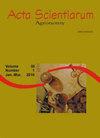Growing apples in tropical semiarid: N and K fertigation
IF 1.2
4区 农林科学
Q3 AGRONOMY
引用次数: 1
Abstract
Apple tree has been experimentally grown Brazilian tropical semiarid. In these new regions, fertilizing management research for N and K is crucial to reach apple high yields. Therefore, an experiment was conducted to evaluate the effect of N and K fertilizing on fruit production, leaf chlorophyll and N and K nutritional status of apple cv. ‘Julieta’ grown in Brazilian tropical semiarid. The experimental design used was randomized blocks with treatments disposed in a factorial arrangement (4 x 4) referring to nitrogen doses (30, 60, 90, and 120 g of N plant-1) and potassium doses (30, 60, 90, and 120 g of K2O plant-1), with three replications and three plants in each parcel. ‘Julieta’ apple trees propagated by grafting (with ‘M9 filter and Maruba rootstock) and transplanted in 2013 were used in this study. The following variables were evaluated: i) fruit production (kg plant-1); ii) number of fruits (in a plant); iii) leaf chlorophyll index (‘a’, ‘b’, and total); and iv) leaf N and K concentrations (g kg-1). N and K doses effects depend on the consecutive production cycles of apple cv. ‘Julieta’ grown in tropical semiarid. An adequate N supply is very important for the subsequent production cycle. K fertilization until 120 g plant-1 of K2O is not enough to supply K demand of apple cv. ‘Julieta’ grown in tropical semiarid. In tropical semiarid, 60-90 g plant-1 of N through fertirrigation is enough for ‘Julieta’ apple production.在热带半干旱地区种植苹果:氮和钾的施肥
在巴西热带半干旱地区试验种植了苹果树。在这些新区域,氮、钾的施肥管理研究是实现苹果高产的关键。为此,本试验旨在评价施氮、施钾对苹果果实产量、叶片叶绿素和氮、钾营养状况的影响。“朱丽叶”生长在巴西热带半干旱地区。试验设计采用随机分组,按因子排列(4 × 4)处理,涉及氮剂量(30、60、90和120 g N plant-1)和钾剂量(30、60、90和120 g K2O plant-1), 3个重复,每个包3个植株。本研究采用2013年嫁接繁殖的‘Julieta’苹果树(M9滤池和Maruba砧木)。评估了以下变量:i)果实产量(kg plant-1);(一株植物)果实的数量;Iii)叶片叶绿素指数(‘a’、‘b’和total);iv)叶片氮、钾浓度(g kg-1)。施氮量和施钾量的影响取决于苹果的连续生产周期。“朱丽叶”生长在热带半干旱地区。充足的氮素供应对后续的生产周期非常重要。植株1期钾肥施肥至120 g K2O不足以满足苹果植株对钾的需求。“朱丽叶”生长在热带半干旱地区。在热带半干旱地区,通过施肥60-90克植株-1氮肥就足以生产“朱丽叶”苹果。
本文章由计算机程序翻译,如有差异,请以英文原文为准。
求助全文
约1分钟内获得全文
求助全文
来源期刊

Acta Scientiarum. Agronomy.
Agricultural and Biological Sciences-Agronomy and Crop Science
CiteScore
2.40
自引率
0.00%
发文量
45
审稿时长
>12 weeks
期刊介绍:
The journal publishes original articles in all areas of Agronomy, including soil sciences, agricultural entomology, soil fertility and manuring, soil physics, physiology of cultivated plants, phytopathology, phyto-health, phytotechny, genesis, morphology and soil classification, management and conservation of soil, integrated management of plant pests, vegetal improvement, agricultural microbiology, agricultural parasitology, production and processing of seeds.
 求助内容:
求助内容: 应助结果提醒方式:
应助结果提醒方式:


